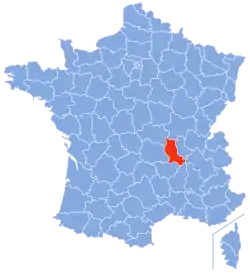Loire (department)
Loire (French pronunciation: [lwaʁ]; Francoprovençal: Lêre; Occitan: Léger) is a department in Auvergne-Rhône-Alpes occupying the River Loire's upper reaches.
Loire | |
|---|---|
 Montbrison in 2007 | |
 Flag  Coat of arms | |
 Location of Loire in France | |
| Coordinates: 45°05′N 04°05′E | |
| Country | France |
| Region | Auvergne-Rhône-Alpes |
| Prefecture | Saint-Étienne |
| Subprefectures | Montbrison Roanne |
| Government | |
| • President of the General Council | Bernard Bonne (UMP) |
| Area | |
| • Total | 4,781 km2 (1,846 sq mi) |
| Population (2016) | |
| • Total | 761,997 |
| • Rank | 30th |
| • Density | 160/km2 (410/sq mi) |
| Time zone | UTC+1 (CET) |
| • Summer (DST) | UTC+2 (CEST) |
| Department number | 42 |
| Arrondissements | 3 |
| Cantons | 21 |
| Communes | 323 |
| ^1 French Land Register data, which exclude estuaries, and lakes, ponds, and glaciers larger than 1 km2 | |
History
Loire was created in 1793 when the Rhône-et-Loire department was split into two, about 3½ years after it was created. This was a response to counter-revolutionary activities in Lyon which, by population, was the country's second largest city. By splitting Rhône-et-Loire the government sought to protect the French Revolution from the potential power and influence of counter revolutionary activity in the Lyon region.
The departmental capitals throughout its history are as follows:
- Feurs 1793–1795
- Montbrison 1795–1855
- Saint-Étienne since 1855
Geography
Loire is part of the current administrative region of Auvergne-Rhône-Alpes and is surrounded by the departments of Rhône, Isère, Ardèche, Haute-Loire, Puy-de-Dôme, Allier, and Saône-et-Loire.
The River Loire traverses the department from south to north.
The Loire department is split into three arrondissements:
Parts of the department belong to Parc naturel régional Livradois-Forez.
Demographics
The inhabitants of the department are called Ligériens.
The industrial city of Saint-Étienne with its suburbs contains some 290,000 of the area's 728,542 inhabitants.
Population development since 1801:
| Year | Pop. | ±% p.a. |
|---|---|---|
| 1801 | 290,903 | — |
| 1806 | 317,053 | +1.74% |
| 1821 | 343,454 | +0.53% |
| 1831 | 391,216 | +1.31% |
| 1841 | 434,085 | +1.05% |
| 1851 | 472,588 | +0.85% |
| 1861 | 517,603 | +0.91% |
| 1872 | 550,611 | +0.56% |
| 1881 | 599,836 | +0.96% |
| 1891 | 616,227 | +0.27% |
| 1901 | 647,633 | +0.50% |
| 1911 | 640,549 | −0.11% |
| 1921 | 637,130 | −0.05% |
| 1931 | 664,822 | +0.43% |
| 1936 | 650,226 | −0.44% |
| 1946 | 631,591 | −0.29% |
| 1954 | 654,482 | +0.45% |
| 1962 | 696,348 | +0.78% |
| 1968 | 722,443 | +0.62% |
| 1975 | 742,396 | +0.39% |
| 1982 | 739,521 | −0.06% |
| 1990 | 746,288 | +0.11% |
| 1999 | 728,524 | −0.27% |
| 2006 | 741,269 | +0.25% |
| 2011 | 749,053 | +0.21% |
| 2016 | 761,997 | +0.34% |
| source:[1] | ||
Politics
Current National Assembly Representatives
Tourism
See also
References
External links
- (in French) Prefecture website
- (in French) Loire General Council




